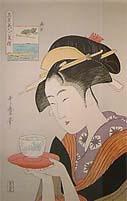

 |
Advanced
Moto style Sake recipe
19% alc/vol |
|
Overview
This recipe will create a really top quality Nigorizake style Sake with a level of 19% alc/vol. This is a sake with no effort spared, it even surpasses the intermediate recipe. It is essential that the reader is familiar with the Basic Sake recipe and is familiar with making malt-rice (Kome Koji). The advanced sake recipe firstly creates a starter culture (Moto) that will create a rich lactic acid and yeast slurry that will start your brew with the desired micro-organisms. The remaining rice and koji is added over a 4 day period and then allowed to brew for a further 16 days.
Your 785 grams of malt rice (Kome Koji) can be made in one session and stored in the freezer and used as required.
The Moto is created at a temperature of 5-10°centigrade(40°-50° F), at these temperatures lactic acid organisms becomes dominant and provide a very suitable medium to establish a thriving yeast culture. Lactic acid is very important to provide the right flavor and prevent unwanted infections. It is wise to use a yeast that works well in lower temperatures. Lager yeast will do the job very well, and yes, under these brewing conditions will reach a 19% alc/vol level. Keep the brewing container at 10°-15° centigrade(50°-60° F) during the whole fermentation process.
Step One: Create your Moto starter culture.
Step Two: Mix your starter culture (Moto) with three additions of rice, water and malt-rice (Kome Koji) to create a brew with the right micro-organisms.
Instructions for advanced recipe (producing 3 liters)
Step One: Making Moto
Materials:
187.5 grams steamed rice
75 grams Kome-Koji
270ml water (chilled, soft, chlorine and iron free)
5 grams suitable low temperature yeast i.e. lager yeast. As starch is converted to sugar then alcohol in one instantaneous process, unusually high alcohol levels (19% alc/vol) can be created from low alcohol yeasts.
Procedure:
Combine all ingredients and keep in the fridge for 10 days at a temperature of 5-10°centigrade(40°-50° F), stir the mixture a couple of times a day. The texture will change gradually from swollen rice grains to a porridge texture as the days go by and will eventually become a creamy soup texture. The yeast becomes active after 3 days and the surface will appear to bubble.
The taste also changes from sweet to slightly acidic and finally acidic and bitter. By this stage 10 days should have elapsed and now the moto is ready to do its work.
Step Two: Brewing Sake with Moto and the three water/rice/Kome Koji additions
Materials: (Total)
3870 ml chilled iron/chlorine free water
710 grams Kome Koji
2250 grams rice (short grain)
All of the prepared Moto (as described above)
Procedure:
Day 1: Steam cook the 375 grams of rice.Cool it and combine with 450 ml of water, all of the Moto and 150 gramsof Kome Koji in a suitable sanitized brewing container (12 litre, stainless steel/ceramic/glass) and stir thoroughly, keeping the brewing container at about 10°-15° centigrade(50°-60° F). After:15 hours stir gently and stir again every few hours. The rice will absorb the water and you will have a swollen rice grain texture with no visible fluid.
Day 2: No additional materials required. Stir gently a couple times a day.
Day 3: Steam cook the 750 grams of rice, cool it, add together with 225 grams Kome Koji and 1170 ml of water to the brewing container and mix well. Wait for ten hours before stiring (this delay helps the yeast and alcohol production) and the preferably stir every few hours. Keep the brewing container at about 10°-15° centigrade(50°-60° F).
Day 4: Steam cook the 1125 grams of rice, cool it, add together with 335 grams kome-koji and 2250 ml of water to the brewing container and mix well. Wait for ten hours before stiring (this delay helps the yeast and alcohol production) and the preferably stir every few hours. Keep the brewing container at about 10°-15° centigrade(50°-60° F)
Day 5-7: There should be a lot of yeast activity during this period with the surface of the brew being very frothy indeed.
Day 8: The yeast activity will be subsiding with a new complex bitterness and acidity in the taste. The texture should change from porridge to soup.
Day 10: Alc/vol is now approx15% with some yeast activity.
Day 14: Alc/vol is now approx17.5% with further reduction in yeast activity.
Day 16: Alc/vol is now approx18.5% with further reduction in yeast activity.
Day 20: Alc/vol is now 19% with further reduction in yeast activity. the brew is ready to be strained through cheese cloth or nylon straining bag, pasteurized and bottled.
Brewing containers and bottles should be sterilized by washing with Sodium Metabisulphate. Please use caution when using this product and be sure to read the manufacturers instructions carefully. Household bleach can also be used for sterilising, again follow manufactures instructions.
Pasteurizing: Sake that is stored with yeasts still alive in the bottle may be unstable and not preserve well. Sake can be stabilised by pasteurising, this process requires GENTLY heating the strained brew in a saucepan for 5 mins at 55 degrees centigrade(132° F), this will slightly change the character of the drink. Ignore any strange smell given off by the decaying yeasts, this will vanish within 6 days. Allow the sake to cool before bottling. This bottle will be now good for many years while it remains unopened. Generally sake will improve for the first few months after bottling. Leave it for at least a week after pasteurising before drinking. Any sterile sealed bottle will work well for storing Sake. Store in a dark place as light does not agree with Sake. One can choose not to pasteurise, however be sure to keep the Sake refrigerated at all times to preserve it well.
Copyright 2013 Vision Brewing. All rights reserved.